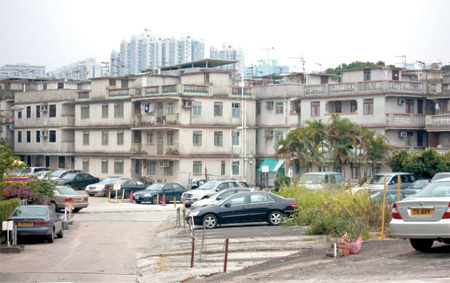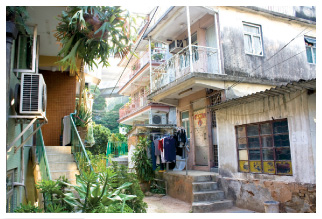An deal you can flip over
Updated: 2011-05-24 07:05
By Christopher Dewolf(HK Edition)
|
|||||||||
|
Critics of the Small House Policy say it has led to unsightly village sprawl, like in Fanling Wai, a 700-year-old village that is now one of the largest in Hong Kong. Christopher Dewolf / for China Daily |
|
Early houses built under the Small House Policy, like this one near Tsuen Wan, were no more than 700 square feet. But later changes to the policy allowed houses as large as 2,100 square feet, creating a new supply of spacious suburban homes. Christopher Dewolf / for China Daily |
|
After the Small House Policy was introduced in 1972, Tai Po Tsai expanded dramatically as new houses were built. The village now has a suburban character and is home to many commuters who work on Hong Kong Island and in Kowloon. Christopher Dewolf / for China Daily |
For many, the SAR's Small House Policy has proven a path to riches. But observers say the entitlement allowing men to build homes in their ancestral villages threatens to cause chaos. Christopher DeWolf reports.
Sam Wan was 10 years old when his father, an officer in the Royal Hong Kong Police Force, died in the line of duty. Reeling from the death of their father, Wan's family moved from their Tsim Sha Tsui apartment back to their ancestral village, Tai Po Tsai, where they owned a small tile-roofed house.
It was 1966 and the village couldn't have been more different from Kowloon. Situated on a small plateau beneath Razor Hill, about halfway between Clear Water Bay and Sai Kung Town, Tai Po Tsai was a centuries-old collection of ramshackle houses and farm fields. Almost everyone in the village was related to a common ancestor. Most of them made a modest living.
"The villagers were small-scale farmers - they grew rice and vegetables for sale in the market in Sai Kung," recalls Wan.
"Their income was not very good, so most of the male villagers went outside to work as ship's crew members. Some went to England to work as laborers or in Chinese restaurants."
But things were changing. Shaw Brothers had opened a film studio nearby in 1961 and many of the studio's employees, including some future film stars, started renting houses in the village. Then, in 1972, a revolution: the government passed the Small House Policy, which gave each male villager and his descendants the right to build a 700-square-foot house in the village without having to pay a land premium or licence fee.
The Wans took advantage of the new law to build a house for themselves on the slope above the village, which soon filled up with other houses. In the 1980s, the maximum size of a village house was increased to 2,100 square feet, so many villagers rebuilt their houses and divided them into three flats, keeping one for themselves and renting out the others for profit.
"Over time the momentum built up, so that many outsiders from the city learned about Tai Po Tsai and the rental market developed quite fast," says Wan.
Today, Tai Po Tsai looks like most other villages in the New Territories: a dense forest of cookie-cutter houses built as closely together as possible.
New groves of houses are sprouting in the New Territories' 700 other villages. These days, village houses are a hot commodity, selling to local commuters and expats for prices that would have been utterly inconceivable in the 1960s. Many villagers now flip their houses as soon as they are built, pocketing millions of dollars in profit.
There are no hard numbers on how many people are eligible to build such houses, but most estimates peg the number at 250,000 in Hong Kong and abroad. Nearly 9,000 applications for new houses are pending approval. Problems with small house construction are rampant, with critics saying it leads to environmental destruction, illegal construction and corruption.
There is also the fact that the policy inherently discriminates against women.
"While specifically exempted from the Sex Discrimination Ordinance, it certainly breaches the spirit of that ordinance," stated a 2003 report by the think tank Civic Exchange.
The same report noted that the policy also violates several of the United Nations human rights treaties that apply to Hong Kong.
The situation is so bad that government ombudsman Alan Lai issued a report recently blasting the government's approach to small house development, saying its policies "clearly defy common sense and logic".
Critics of the Small House Policy say that if nothing is done to reform the way New Territories villages are managed, Hong Kong is quickly heading towards an unprecedented political and environmental crisis.
"It's a totally unsustainable policy," says Roger Nissim, a former executive with Sun Hung Kai Properties who now teaches at the University of Hong Kong's Department of Real Estate and Construction.
"Every day you have a new indigenous villager born who will one day ask, 'Where's my small house?' There's a fundamental problem because of a lack of land, and because there is no strategic planning in Hong Kong."
It wasn't supposed to be this way. In the early 1970s, most rural villages were poor, and land was becoming so expensive that villagers were unable to build new houses for themselves. The Small House Policy was proposed by the Heung Yee Kuk, a villagers' advocacy group, to make house-building easier and more affordable by establishing a regular process by which a man could build a house for his family in his ancestral village, after marrying a woman from another village. As long as they met certain guidelines - no taller than two stories, no larger than 700 square feet - these houses would be exempt from the Buildings Ordinance because there were few registered architects in the New Territories.
When the policy was implemented in 1972, the District Commissioner for the New Territories, Denis Bray, made it clear that the new houses would exist only for the benefit of villagers.
"Town dwellers looking for weekend bungalow sites or a way into the new towns will be disappointed in this policy," he said in a speech at the Legislative Council.
"This policy is for people who need to live in the country now."
What actually happened was exactly the opposite of what Bray stated. As road and rail links to the New Territories improved and vast industrial and commercial complexes were built in new towns like Sha Tin, village houses became a popular alternative to cramped city apartments. Rules regarding the size of small houses were relaxed as early as 1975.
By the late 1980s, says Civic Exchange co-founder Lisa Hopkinson, "small houses were endemic in the New Territories, and the few villages without (small houses) were either abandoned villages, or villages without vehicle access."
In 1987, illegal development and unchecked sprawl had become such a problem that the government launched an audit report on abuses under the Small House Policy. Regular news investigations - including one published on April 27 by China Daily - tell of villagers who must pay bribes to village leaders before they can build their houses.
According to data from the Development Bureau, around 36,000 small houses have been built since the policy was introduced, a number that grows by nearly 1,000 every year. Since the placement of houses within village boundaries is unregulated, new home construction often causes environmental destruction. Some of the negative environmental effects include "village encroachment on fung shui woodlands, loss of wetland habitat within or around villages, pollution of rivers and streams, dumping of construction waste and building of illegal roads," says Hopkinson.
But many are willing to overlook the damage caused by village houses for one reason: money. Government tax documents suggest that it costs around HK$1.5 million to build a small house; if sold as a single unit, they can fetch more than HK$8 million in many areas - and often more than HK$20 million in popular areas with sea views, according to property brokers in Sai Kung. With those kinds of profits, many villagers simply flip their houses as soon as they are built, a trend documented in the government's 1987 audit and a follow-up report in 2002. Houses are often built to luxurious standards, sometimes with illegal additions like swimming pools, according to ombudsman Lai's recent report.
Despite well-documented instances of illegal construction, corruption and speculative development, however, nothing has been done to reform the Small House Policy. In its 2003 report, Civic Exchange explored several options, including a freeze on village boundaries, banning the resale of small houses to non-villagers, reducing the size of small houses, introducing high-rise village development, creating centralized, master-planned hubs of small house development and repealing the policy outright.
But first, says Hopkinson, there needs to be an open public discussion on how to reform the policy.
"Our recommendations then are just as relevant now," she says.
"Develop an inclusive and public process for key stakeholders to review the policy, see whether the original (policy) objectives are still valid, decide what the objectives for villages should be and what options can best meet those objectives. This should not be a closed discussion between government and the Heung Yee Kuk, who have obvious vested interests in maintaining the policy. This is an issue of relevance to all Hong Kong people."
That is easier said than done. The Heung Yee Kuk maintains a seat on the government's Executive Council, which gives it hefty political leverage, and it has so far resisted any change to the policy. For the time being, the government has promised only to undertake an open-ended review of the policy.
"Any major change would entail complex legal, land use and planning issues which require careful examination," says a spokesperson for the Development Bureau.
Critics of the policy are doubtful that there will be any significant change in the near future.
"In the current climate, there's zero chance of that happening," says Roger Nissim.
"When the panic comes because all the land is used up, what is going to happen?"
The land has already run out in Tai Po Tsai. Hemmed in by the University of Hong Kong and private residential development on three sides, it has little room left to expand, and the wait for a small house application to be approved can drag on for decades.
Sam Wan left Tai Po Tsai in the 1990s. He now lives in Canada and he rents out part of his village house to an expatriate family. Though his two sons are now eligible to apply for a small house, he is wary of the situation the Small House Policy has created.
"There's so many descendants, the policy has become impractical," he says.
"Maybe the next government will do something concrete about it. It's now quite a mess."
(HK Edition 05/24/2011 page4)


